Manuscript accepted on : September 25, 2010
Published online on: 28-12-2010
FT-IR and GC-MS Studies of Dihydroflavonols from Bark Extract of Lannea Coromendelica (Houtt.) Merr.
M. Prabhakaran1*, S. Elumalai1, N. Senthil kumar1 and R. Murugesan2
1PG and Research Department of Plant Biology & Plant Biotechnology, Presidency College, Chennai - 600 005 India
2Indian Institute of Technology Madras (IITM), Sophisticated Analytical Instruments Facility (SAIF), Chennai - 600 036 India.
ABSTRACT: The main objective of the study was to evaluate the dihydroflavonols from bark powder of an important medicinal plant, Lannea coromendelica (Houtt.) Merr. The chemical constituents of L. coromendelica bark acetone extract revealed five dihydroflavonol compounds and they are (2R,3S)-(+)-3',5-dihydroxy-4',7-dimethoxydihydroflavonol (1), (2R,3R)-(+)-4',5',7-trimethoxydihydroflavonol (2), (2R,3R)-(+)-4',7dimethyldihydroquercetin (3), (2R,3R)-(+)-4',7-di-O-methyldihydrokaempferol (4), (2R,3R)-(+)-4'-O-methyldihydroquercetin (5) by FT - IR and GC - MS.
KEYWORDS: Lannea coromendelica (Houtt.) Merr.; Dihydroflavonols; FT - IR; GC - MS
Download this article as:| Copy the following to cite this article: Prabhakaran M, Elumalai S, Kumar N. S, Murugesan R. FT-IR and GC-MS Studies of Dihydroflavonols from Bark Extract of Lannea Coromendelica (Houtt.) Merr. Biosci Biotech Res Asia 2010;7(2) |
| Copy the following to cite this URL: Prabhakaran M, Elumalai S, Kumar N. S, Murugesan R. FT-IR and GC-MS Studies of Dihydroflavonols from Bark Extract of Lannea Coromendelica (Houtt.) Merr. Biosci Biotech Res Asia 2010;7(2). Available from:https://www.biotech-asia.org/?p=9431 |
Introduction
Lannea coromendelica (Houtt.) Merr. (Anacardiaceae) is a deciduous tropical tree widely distributed in India and some other tropical countries. Local name (Tamil) of the plant is Oti, Odi, Vodiyar. Fresh aqueous extract of L. coromendelica bark is a valuable application to sore eyes and obstinate ulcers. Bark, powder mixed with neem oil is an application for chronic ulcers and skin diseases such as impetigo. Powdered bark is used as a paste for leprous ulcers (Nadkarni, 1998). Various phytochemicals have been isolated from Lannea spp., including quercetin-3-O-arabinoside and ellagic acid (Subramanian and Nair, 1971), β-sitosterol, physcion and physcion anthranol B from the bark (Subramanian and Nair, 1971). Hence the present study aims to analyse the dihydroflavonols from bark powder of L. coromendelica.
Materials and Methods
Collection of Plant Material
The identification of the plant was carried out with the help of the Flora of the Presidency of Madras, Gamble. The stem bark of L. coromendelica was collected at Perungudi village, Madurai district, South India in the month of January 2010, with the guidance from Siddha medical practitioners. The material was then shade – dried and coarsely powdered.
Analysis of Dihydro flavonols by FT – IR and GC – MASS Spectrometry
Five grams of L. coromendelica fine bark powder was taken for FT – IR and GC – MS studies. This powder was mixed with citric acid extracted from lemon and beads were prepared. The beads were kept in the oven for removal of citric acid and water. Backing beads were taken in the beaker and to this 10 ml of acetone was added. Then this mixture was kept for 24 hours at room temperature. Reddish brown colour was observed after above mentioned reaction time. This sample was kept in hot air oven for 1 or 2 minutes at 80 °C for removing acetone. For further purification 10 ml of methoxide was also added to this sample and kept for 24 hours at room temperature. Two different layers were observed after 24 hours, the top colourless light yellow layer and the brown colour sediment at the bottom. The top layer of the sample was filtered using Whattman No. 1 filter paper and it was kept in hot air oven for 1 or 2 minutes at 80 °C for removing methoxide. This pure colourless sample was collected and kept at 4 °C for the analysis. Sample were analyzed by Gas Chromatography (GC) and Fourier Transform Infrared Spectroscopy Fourier (FT – IR). Identification of dihydroflavonols were carried out on a Agilant coupled with Jeol GC mate – II Mass Spectrometer. The operating conditions were as follows: Initial column temperature 80 °C programmed at a rate of 5 °C / min to 280 °C: Inlet temperature 250 °C. Carrier gas: Helium. Flow rate 30 ml / min. Perkin Elemer Spectrum – I, instrument was used to identify chemical constituents of the sample. Liquid sample was used for FT – IR Studies, neat spectrum was recorded using sodium chloride disc.
Results and Disscussion
Various phytochemicals have been isolated from Lannea spp., including quercetin-3-O-arabinoside and ellagic acid (Subramanian and Nair, 1971), β-sitosterol, physcion and physcion anthranol B from the bark (Subramanian and Nair, 1971), rutin and quercetin (Sulochana and sastry, 1968), and laceolatin-B and 7,2′-dimethoxy-4’5′-methylenedioxy flavones (Sultana and Ilyas, 1986b) from leaves and flowers, ferulic acid ester from the roots (Govinndachari, et al., 1971) and two cytotoxic hydroguinones, lanneaquinol and 2′-(R)-hydroxylanneaquinol were reported from L. welwitchii (Groweiss, et al.,1997).
FT – IR Spectra were obtained using Perkin Elemer Spectrum – I, instrument was used to identify chemical constituents of the sample. Liquid sample was used for FT – IR Studies, neat spectrum was recorded using Sodium chloride disc. Absorption peaks observed in term of wave numbers (Cm-1).
IR Spectroscopy was carried out to confirm functional groups. IR spectrum presented in Fig. 1 showed absorption peaks of flavonol compounds such as O-H Stretching (3399 Cm-1), C-H Stretching(1449 Cm-1, 1421 Cm-1,1368 Cm1, 699 Cm-1) and COO Stretching ( 1659 Cm-1) was also detected.
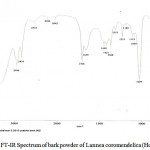 |
Figure 1: FT-IR Spectrum of bark powder of Lannea coromendelica (Houtt.) Merr.
|
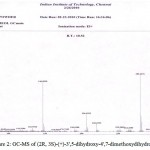 |
Figure 2: GC-MS of (2R, 3S)-(+)-3′,5-dihydroxy-4′,7-dimethoxydihydroflavonol. |
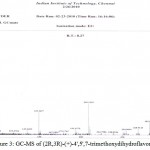 |
Figure 3: GC-MS of (2R,3R)-(+)-4′,5′,7-trimethoxydihydroflavonol.
|
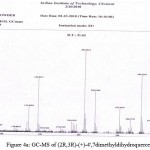 |
Figure A4. GC-MS of (2R,3R)-(+)-4′,7dimethyldihydroquercetin.
|
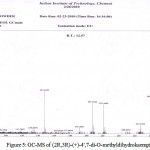 |
Figure 5: GC-MS of (2R,3R)-(+)-4′,7-di-O-methyldihydrokaempferol. |
The GC – MASS and FT – IR studies clearly indicate that the following dihydroflavonols are present in the bark powder of Lannea coromendelica (Houtt.) Merr, (2R,3S)-(+)-3′,5-dihydroxy-4′,7-dimethoxydihydroflavonol (1) [C17H1607- mw 332.0896] and it was confirmed by the presence of peak value is 332.1000 in Fig. 2 and (2R,3R)-(+)-4′,5′,7-trimethoxydihydroflavonol (2) [C18H18O6 – mw 330.1103] it was confirmed by the presence of peak value 330.1000 as shown in Fig. 3 and (2R, 3R)-(+)-4′,7dimethyldihydroquercetin(3) [C17H16O7 – mw 332.0883] it was confirmed by the presence of peak value 332.1000 as shown in Fig. 4 and (2R,3R)-(+)-4′,7-di-O-methyldihydrokaempferol (4) [C17H16O6 – mw 316.0947] it was clearly confirmed by the presence of peak value is 316.0947 as shown in Fig. 5 and (2R,3R)-(+)-4′-O-methyldihydroquercetin (5) [C16H14O7 – mw 318.0739] it was confirmed by the presence of peak value 318.0733 as shown in Fig. 6.
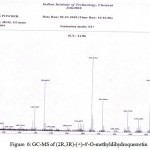 |
Figure 6: GC-MS of (2R,3R)-(+)-4′-O-methyldihydroquercetin.
|
Acknowledgements
The authors thanks to The Principal and Head, Plant Biotechnology Department, Presidency College, Chennai – 600 005 and SAIF (Sophisticated Analytical Instruments Facility), IITM, Chennai -600 036.
References
- Govindachari, T.R., Parthasarathi, P.C., Desai, H.K. and Mohamed, P.A., Cluytyl ferulate, a new long chain ester from Gemelina arbora and Lannea grandis. Indian Journal of Chemistry, 9: 1027 (1971).
- Groweiss, A., Cardellina II, J.H., Pannell, L.K., Uyakul, D., Kashman, Y and Boyd, M.R., Novel cytotoxic, alkylated hydroquinones from Lannea welwitschii. Journal of Natural Products, 60: 116-120 (1997).
- Langfield, R.D., Scarano, F.J., Heitzman, M.E., Kondo, M., Hammond, G.B and Neto, C.C., Use of a modified microplate bioassay method to investigate antibacterial activity in the Peruvian medicinal plant Peperomia galioides. Journal of Ethnopharmacology, 94: 279-281 (2004).
- Nadkarni, K.M., Indian material medica. Popular Prakashan Pvt. Ltd., 1: 867-868 (1998).
- Subramanian, S.S and Nair, A.G.R., Angiospermae dicotyledonae Anacardiaceae, polyphenols of Lannea coromandelica. Phytochemistry, 10: 1939-1940 (1971).
- Sulochana, V and Sastry, K.N.S., Isolation of rutin and quercetin from Odina (Lannea grandis) leaves. Leather Science, 15: 170-171 (1968).
- Sultana, S., and Ilyas, M., Isoltion of a new flavanone and lanceolatin-B from Lannea acida (Rich). Indian Journal of Chemistry, 25B: 416 (1986b).

This work is licensed under a Creative Commons Attribution 4.0 International License.





